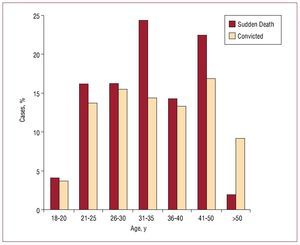To the Editor:
We have performed a systematic review of sudden and unexplained deaths in the first 24 hours following police detention in Spain within the last 10 years. We searched for "death following police detention" or equivalent expressions in general newspaper and agency search engines.
We found 60 deaths without an apparent cause. Only 1 (1.7%) case was in a female who died after approximately 20 hours of detention. This percentage contrasts with the fact that women represent 10% of all detentions.1 Fifty-nine cases were of young men with a median age of 33.5 (8.7) (range, 18-58) years, without a history of cardiovascular disease. Out of those detained, 17 (28.8%) had a medical history (12 drug addicts, 4 psychiatric diseases, and 1 treated for rehabilitation). Medication was administered prior to the episode in 4 (6.8%) cases (sedatives in 3 and methadone in 1). Death was immediate in 17 (28.8%) cases in the detention centre, with a similar age to those who died after leaving the site (35.8 [9.5] and 32.3 [8.3] years, respectively; P=.20). Figure shows that the distribution by age is similar to that of the convicted males. We found 7 cases in the first 3 years (1998-2000), 20 in the next 3 (2001-2003), and 32 in the last 3 (2004-2007, including the first 11 days of 2008).
Figure. Percent distributions by age of the males with sudden death in the first 24 hours following police detention in our study compared to that of convicted males in Spain in 2006.
General adaptation syndrome in animals was described more than 50 years ago, which frequently leads to sudden death following capture. This is a reaction to high-stress situations that is mediated by catecholamines.2 It has been shown that this syndrome originates in the heart, and the case of a black swan that died in the first 12 hours after capture due to heart rupture at the level of the apex has been described.3
A tako-tsubo-type stress-induced cardiomyopathy has recently been described in humans, which is also related to high catecholamine levels.4 It is typically seen in postmenopausal women, though it also affects men (up to 20%) and persons under 40 years of age. The stress trigger is more common in white patients5 and the initial symptom occasionally is cardiac arrest with a rate of ventricular fibrillation of up to 9%.4 Death due to cardiac rupture at the level of the apex has also been reported in this cardiomyopathy.6 Additionally, it is known that the capture and immobilization of a rat reproduces the electrocardiographic changes and the changes in ventricular contraction that are seen in stress cardiomyopathy, and that an increase in estrogens reduces these cardiac changes7, which may explain the greater frequency of this syndrome in males.
The data has been obtained from non-scientific publications which limits its reliability and doesn't allow for determination of sensitivity and specificity. It cannot be ruled out that there have been more sudden and unexplained deaths following police detention than those described here. This is less probable in recent years due to the social alarm that is usually generated by these deaths and their spread. Nevertheless, regarding the first years of our series, the information available from the internet is scarcer, which is why there are probably more cases than those described here. An autopsy is performed on deaths under custody, but we have not had access to the autopsy reports and their results may have been published, but a definitive cause of death was not determined, or at least not made public.
Sudden death syndrome in young males following police detention and general adaptation syndrome in animals may share the same pathophysiological mechanism. Though it is only speculative, takotsubo-type stress-induced cardiomyopathy may be related to these syndromes, and their common aetiology would be the rapid release of high concentrations of catecholamines into the bloodstream.


